Augmented Reality (AR)

Augmented Reality in Tourism and Travel
13 minute read
October 18th, 2023

Rock Paper Reality
Share this article.
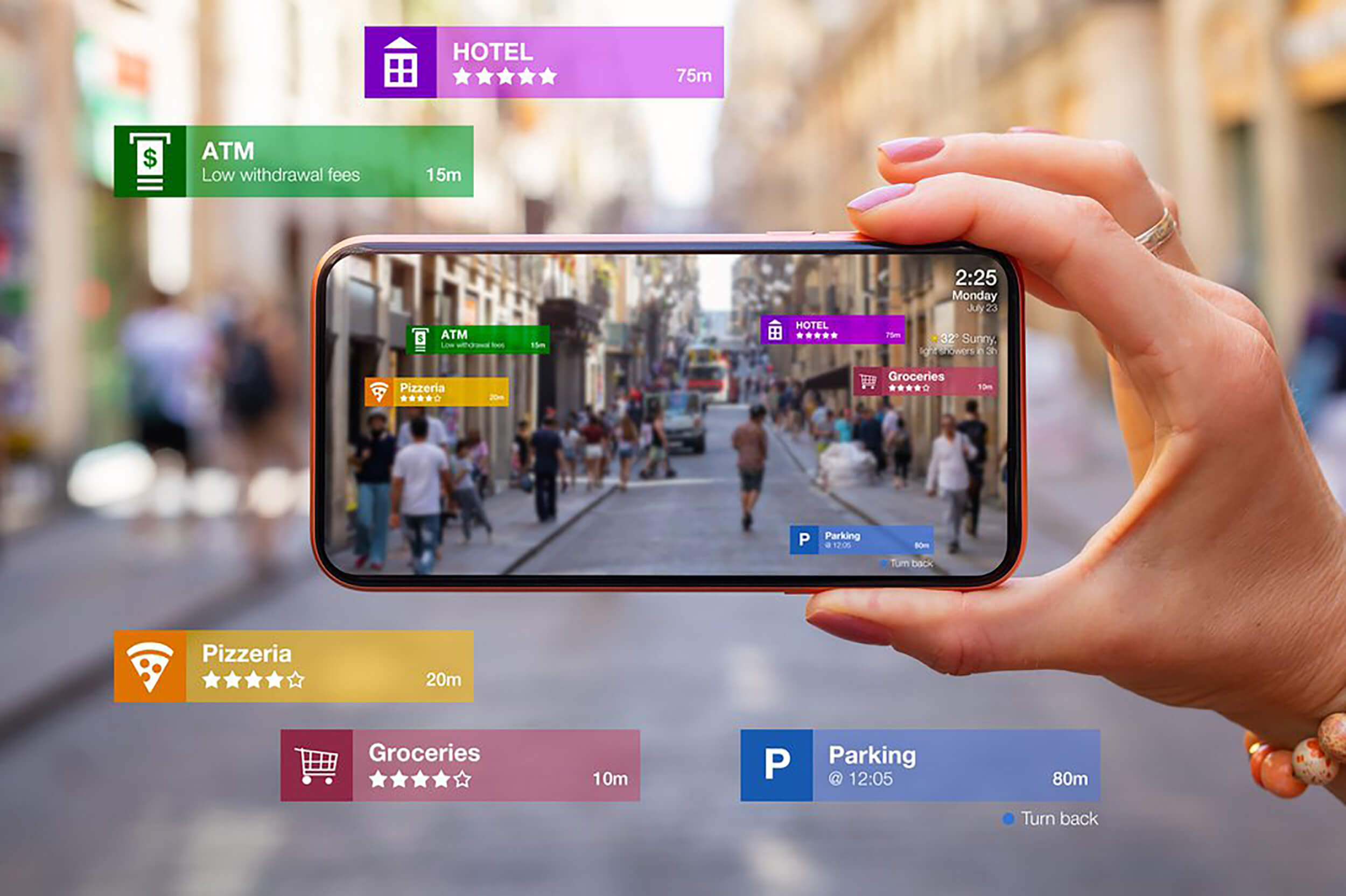
Augmented reality (AR) is revolutionizing the way we travel and interact with the world. From interactive maps and personalised recommendations to remote assistants and translation apps, the potential for AR usage in tourism is boundless. The virtual tourism market alone is set to grow at a compound annual growth rate (CAGR) of 30.2% between 2023 and 2028, to reach a valuation of $23.5 billion. There is no doubt that augmented reality is reshaping the tourism industry, empowering brands to remain relevant in a competitive and changing market space.
With informative overlays and augmented attractions, this transformative technology seamlessly blends the physical and digital to offer new immersive experiences. Augmented reality in tourism doesn’t only enhance customer satisfaction but enables next-level marketing and opens up new revenue streams for travel businesses.
Let’s explore the many ways that the use of augmented reality in travel and tourism can shake up your business with remarkable competitive advantages.
Key Takeaways
- AR enables travel operators to enhance their services by offering simplified navigation, on-demand destination information, and eliminating language barriers.
- AR helps agents and operators improve travel personalization—a key component to fostering engagement and customer satisfaction.
- AR in travel opens avenues for new revenue streams and improves consumer confidence by allowing customers to gain detailed insights before committing to a booking.
- AR tourism tools in hospitality establishments can significantly reduce operational and administrative costs. They can also help drive bookings to on-site services and improve guest experiences.
How Can AR Enhance Travel Experiences?
As the quality of augmented reality improves and increased accessibility leads to lower implementation costs, AR is becoming increasingly popular as a travel tool. Whether it’s a museum visit or a trip to a foreign country, AR promises to change, improve, and expand the very nature of travel and tourism.
Enabling the Use of AR Travel Guides to Explore Destinations Virtually
Although the experience of travel is proverbially priceless, the truth is that it can put quite a dent in your client’s pocket. An augmented reality travel guide can help ensure that the destination your clients spend their money on is just as beautiful as the brochure promises.
Using AR, tourists can explore famous landmarks, interactive museums, and natural wonders from the comfort of their own homes. They can view 3D models of iconic buildings like the Eiffel Tower or the Taj Mahal and even take virtual walking tours through bustling city streets or far-flung wilderness. An example of this is the travel app Antarctic Heritage Trust AR , which takes users on an expedition to Antarctica. Here a user can explore the icy landscape with 360º images and videos and access artefacts from the buildings.
AR also allows tourists to learn about the history and culture of a destination through interactive exhibits, historical reenactments, and educational games. Augmented reality travel apps can depict how an area looked in the past and restore historical scenes and events. It can also invite users to preview exciting new sites currently under construction.
Historik is a tourism app that recreates historic buildings and objects at specific points of interest. By pointing their mobile camera at a landmark, travelers can access a visual representation of the history and significance of the site. They can swipe through artefacts and even set up self-guided tours.
The Benefits of an AR Travel Guide
By allowing your clients to explore destinations virtually with integrated AR, you’ll offer the following unique benefits:
- Increased accessibility – AR technology allows people with limited mobility or disabilities to experience and explore destinations that might otherwise be inaccessible to them.
- Improved buyer confidence – By first experiencing a destination virtually, travelers can make more informed decisions. When they book the real adventure, they’ll be sure to pick the right option for them, reducing the risk of refunds and complaints.
- Enhanced educational opportunities – AR can provide interactive and informative experiences that truly add value. It can be used to efficiently inform travelers about the history, culture, and natural wonders of a destination.
Leveraging AR to Navigate Unfamiliar Places
With its ability to blend the virtual and physical, tourists can use AR for navigation. When exploring an new area, a traveler can point their mobile phone camera into the street and sit back while an AR tourist guide superimposes directions on the view. With real-time directions and a visual orientation of where they are, they can navigate unknown places with ease.
For example, the AR tourism app World Around Me highlights nearby ATMs, restaurants, hotels, attractions, hospitals, shops, and transportation stops. Similarly, PeakVisor enhances outdoor activities by providing interactive guides for hiking trails, mountaineering, and adventure sports.
Using AR to Entertain Guests
AR can add a new dimension to your guest experiences at museums, art galleries, historical sites, and other attractions. Besides offering augmented reality tour guides on the traveler’s mobile phone, AR apps can also offer real-time information about paintings, artefacts, animals, and more.
For example, Museum Buddy offers self-guided tours, object narrations, museum maps, and a wealth of information for some of the world’s most popular museums. What would traditionally be a one-way viewing encounter can now become an immersive cultural experience, enabling visitors to truly submerge themselves in an era or environment.
Additionally, AR travel gaming apps such as Geocaching engage visitors in virtual treasure hunts or invite them to solve puzzles. This can take exploring parks, zoos, gardens, and historical sites to a new level of fun.
How Can AR Improve Customer Satisfaction in Travel and Tourism?
Integrating AR into customer experiences is key for travel and tourism companies that wish to stay competitive. In 2021, the AR market was worth $8.6 billion, and it is forecasted to grow at a CAGR of 38% by 2030.
This rapid expansion only serves as testament to how powerful AR is in helping businesses deliver better customer service.
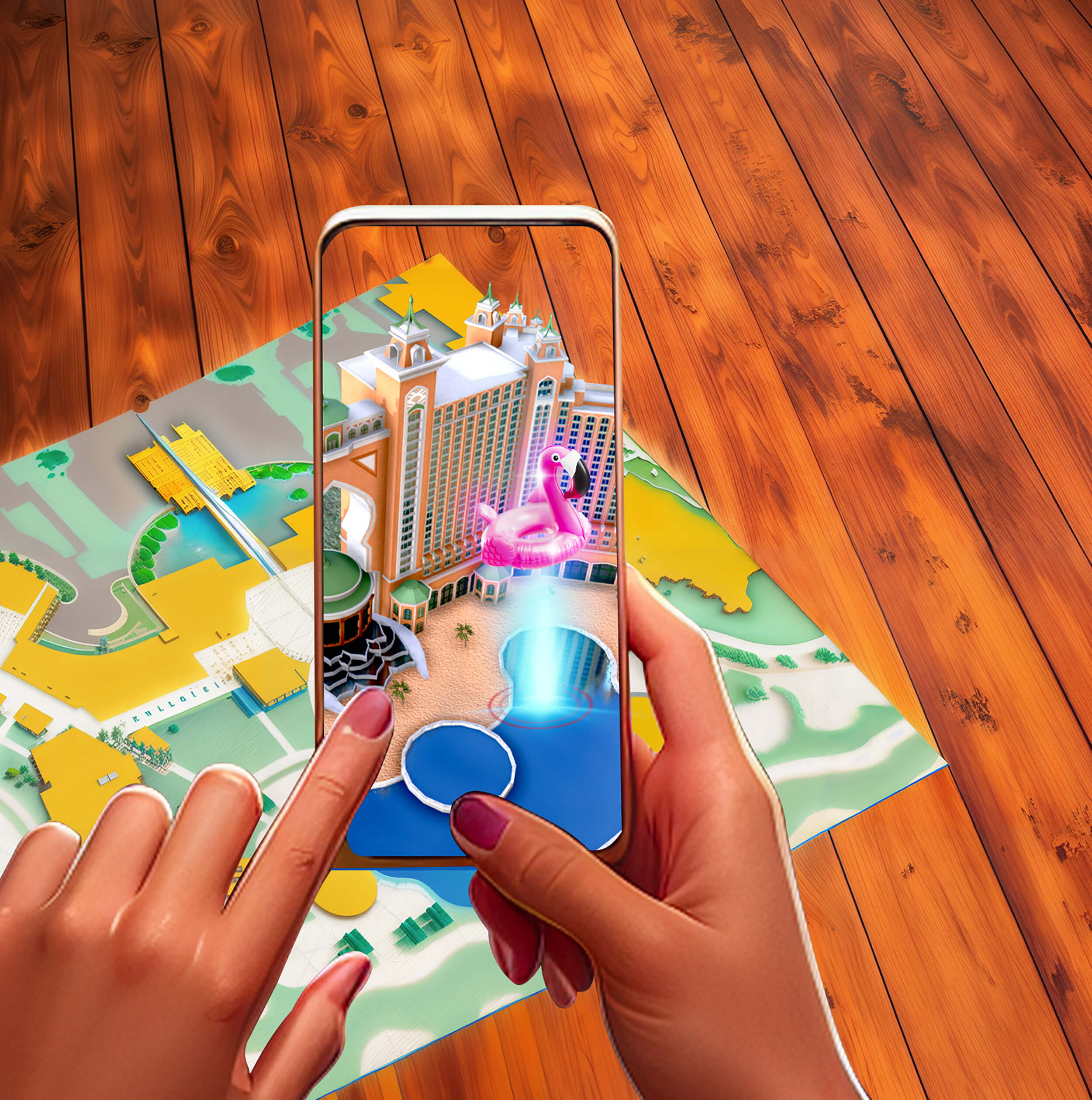
Using AR to Provide Personalized Travel Experiences
With competition fiercer than ever, the key to standing out is providing a high quality, uniquely personal experience. In fact, 63% of customers say they will stop using a brand if it uses poor personalization tactics .
With ready-made packages and all-inclusive deals, traditional travel itineraries and activities are often a one-size-fits-all approach. But what if you could tailor every part of your customer’s journey, certain that they will love what they get? You can. With AR integrations and features, your clients can book a room after virtually browsing multiple options, seamlessly navigate points of interest to them, and enjoy interactive, tailored itineraries.
Improving Customer Communication and Collaboration Through AR
Using AR, customers can leave reviews and ratings for places they visit in real time. This feedback is invaluable for travel and hospitality businesses and can help to enhance communication with your audiences. You could also consider implementing useful features like AR avatars or virtual representatives to guide customers through their travel experiences. These avatars can provide assistance, suggest activities, and answer common questions, improving communication and customer support.
How Can AR Increase Travel and Tourism Revenue?
AR features can captivate visitors, streamline the travel experience and drastically enhance visitor interactions. From informative overlays to real-time translations, these tools can drive engagement, confidence and ultimately consumer spending.
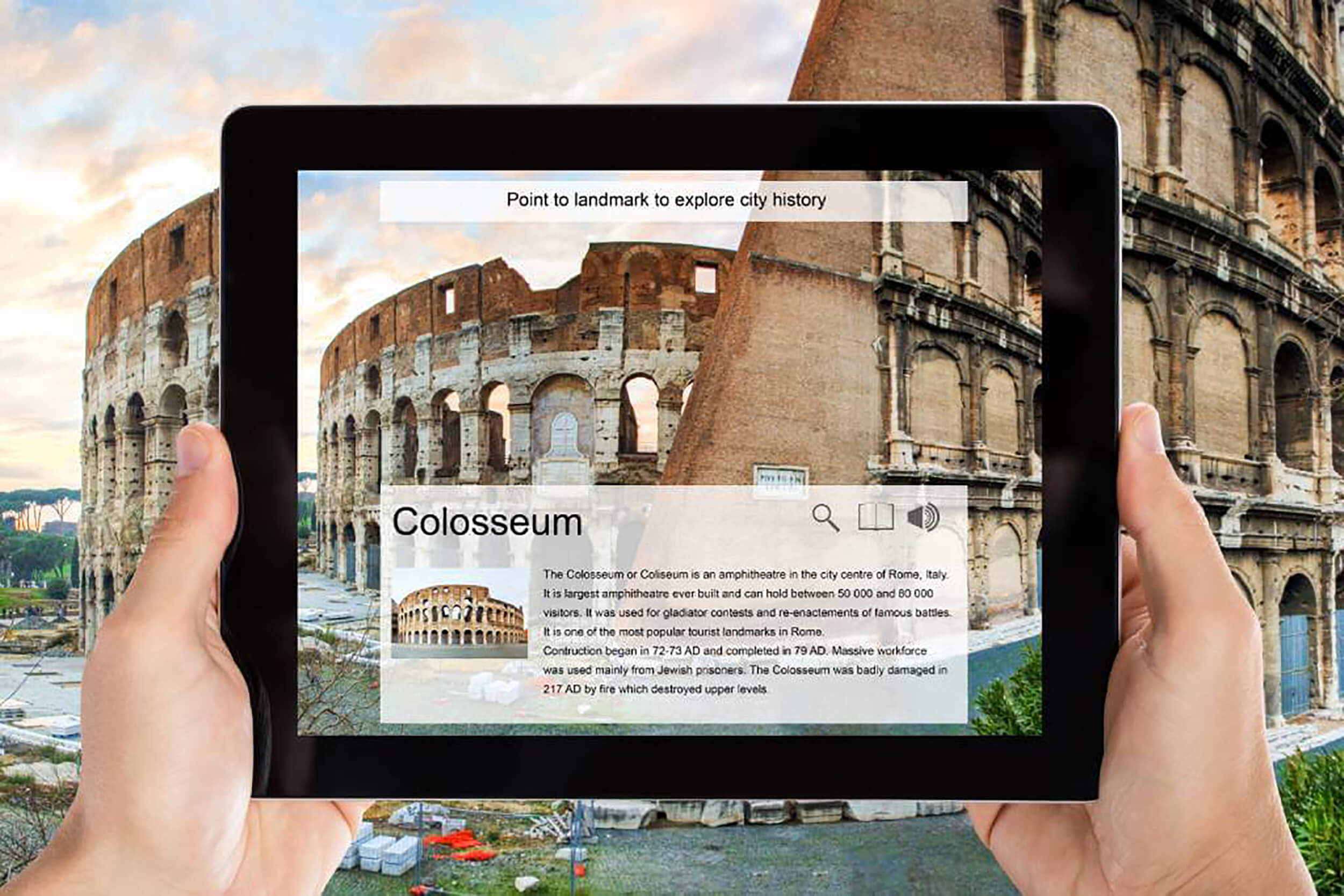
AR can also help travel and tourism businesses to move into new markets and expand their offerings in ways that differentiate them from their competitors. Here are some opportunities for building new revenue streams using AR:
Enhanced Virtual Tours
Users can explore destinations virtually, navigate attractions, and even interact with virtual elements in real time. This technology opens up opportunities to generate revenue through augmented tours, ticket sales, and partnerships with local businesses.
Virtual Shopping Experiences
AR technology can transform traditional souvenir shopping. Using AR-enabled apps or devices, tourists can virtually try on clothing, accessories, or test products before purchase.
This not only enhances the shopping experience but provides a unique way for travel companies to generate additional revenue. They can partner with local retailers to offer exclusive discounts and promotions for AR shoppers. This creates a win-win situation for both travelers and businesses.
Smartify’s eShop platform, for instance, lets users access art from galleries like The National Gallery in London and buy prints, souvenirs, mementos, and gifts directly from their smartphone.
Augmented Advertising
With AR-enabled devices, marketers can create interactive and engaging advertisements that blend seamlessly with real-world environments. Featuring creative design work and animation, these campaigns extend your brand into the digital layer and can be highly impactful.
Gamification in Travel & Tourism
With integrated game-like features, users can participate in interactive challenges, complete quests, and earn rewards as they explore different destinations. Jurassic World Alive is a prime example of this. The app invites users to find virtual dinosaurs in different real-world locations, enabling them to learn about the ancient creatures at the same time.
Applying this concept in various settings can make travel more engaging and educational. It also provides opportunities for travel and tourism companies to generate additional revenue. They can offer premium game experiences, extra features, or in-game purchases and upgrades.
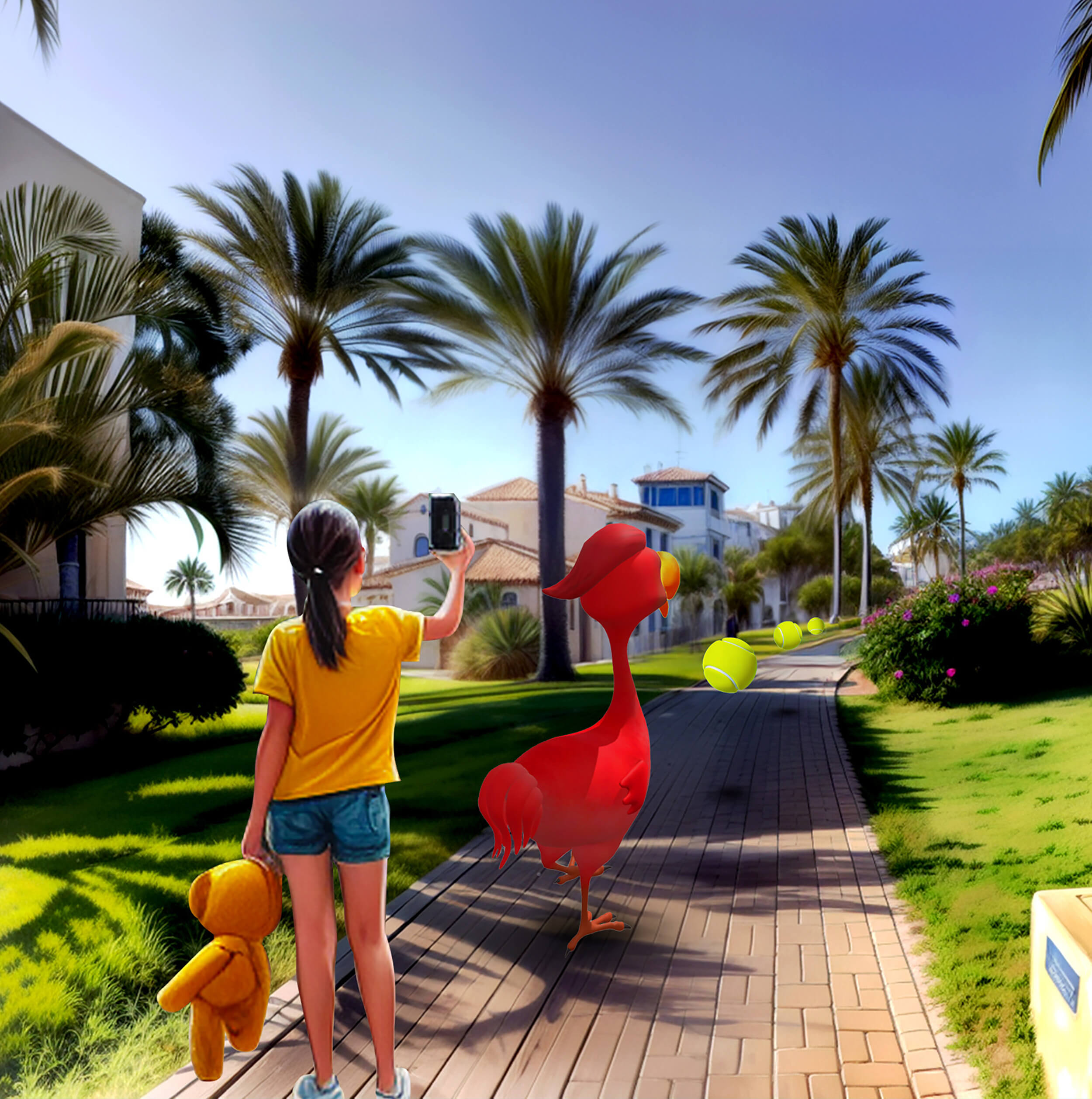
AR as a Tool to Boost Sales and Conversion
By providing virtual tours of destinations, cruise ships, and leisure facilities, travel agents and marketers give potential customers a sneak peek into holiday bliss. This can increase interest and likelihood of booking.
AR also makes it easy for travelers to book day tours on demand. They can browse and engage in activity options from within an app—and use the same app to instantly book the activity. This is especially useful for weather-dependent activities or to avoid long lines.
How Can You Leverage AR in the Hospitality Industry?
Leveraging augmented reality in hospitality has the power to turn your customer experiences—and your bottom line—around. AR tools can reduce operational, training, and administrative costs, improve the guest experience, and drive more bookings.
AR in Hotels
Holiday Inn uses augmented reality to offer virtual 360º hotel tours to prospective visitors. These tours help users to:
- Decide which room size is the best fit for them
- Get a realistic idea of amenities
- Explore leisure and dining facilities
- Evaluate the suitability and capacity of conference and event rooms
- Explore room upgrade advantages and compare the benefits
- Gain a comprehensive overview of the facility layout, room privacy, noise levels, and views
Furthermore, you can integrate AR with social media platforms to create interactive and shareable content, increasing brand exposure and engagement.
Training Hotel Staff Using AR
AR can enable employees to learn in a hands-on manner. They can use AR tools to visualize complex processes, simulate real-life scenarios, and receive real-time feedback. They can also practise handling customer-facing scenarios in an augmented environment and receive enhanced training with interactive guides and demonstrations.
Improving Guest Services With AR in Hotels
AR brings a whole new dimension of convenience to the way guests interact with hotels. With virtual concierge services, visitors can instantly access information, make bookings, and request assistance by simply scanning their surroundings. Whether it’s making a dinner reservation, finding out how the entertainment system works, or getting directions to the fitness center, guests can access everything in the palm of their hand.
Holding a mobile phone camera toward the entertainment system might cause an overlay with instructions to appear on the screen. Or, as a user points their camera down the hallway, the AR application might superimpose directions to the restaurant, spa, or fitness center
AR can also enhance dining experiences. By scanning a menu, guests could access information or ingredients, or even see how the dish was prepared. They could also scan a bottle label, as in the case of Chronic Cellars Purple Paradise , to access games.
Similarly, prestigious Scotch whisky brand The Glenlivet partnered with Rock Paper Reality to create a virtual tasting room , so as to expand whisky access and education to a new swathe of younger consumers. The Sample Room experience immerses users in the heart of a 360º tasting room, where they can learn more about the story behind the brand’s 18-, 21- and 25-year expressions—all by scanning a QR code on the back of a bottle. An AR tool like this offers twofold advantages for hospitality establishments: educate staff on the fly, and enhance the guest experience.
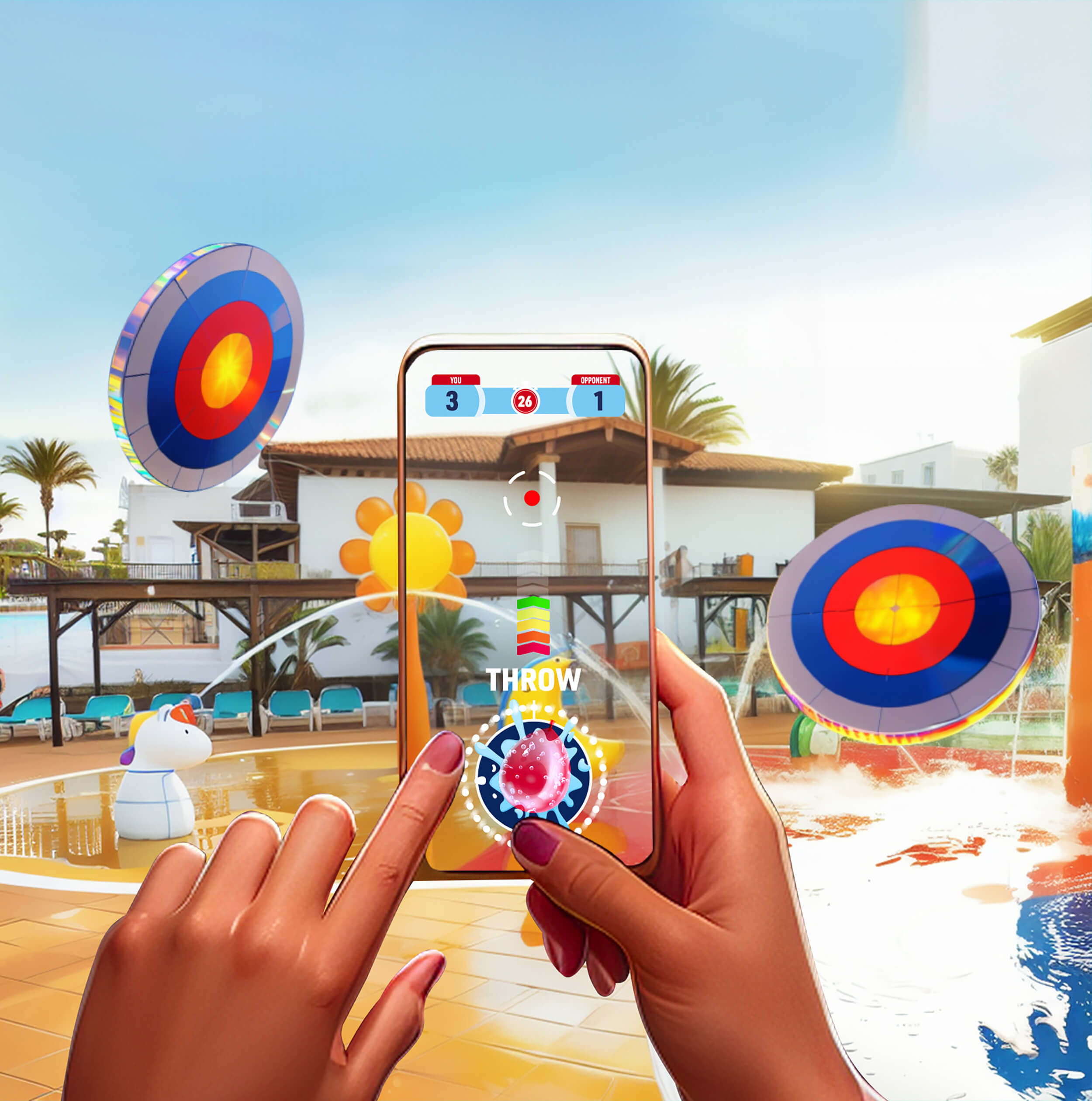
Augmented Reality: The Future of Tourism
Augmented reality is transforming the tourism industry and shaping the future of travel experiences. It holds immense potential to offer travellers a whole new way to explore and engage with the world around them.
Rock Paper Reality can help you take full advantage of this technology to drive growth in your travel or tourism business. From Fortune 500s to start-ups, we’ve been helping companies leverage the latest technology to drive growth strategies for over a decade.
Our team of highly skilled innovators looks forward to bringing your augmented reality vision to life. Let’s chat .
Stay in the know
Sign up to our newsletter for exclusive updates and content, delivered directly to your inbox.
You can opt out at any time, please view our Privacy Policy for more information on how to unsubscribe.

The Transformative Role of AR and VR in Travel: An Overview
by Sienna Smith | Jan 25, 2024 | Augmented Reality Travel , Virtual Reality Travel | 0 comments

Table Of Contents
Introduction to Augmented and Virtual Reality in Travel
- Overview of AR and VR in the Travel Industry
- Transformative Impact on Travel Experiences
Emergence of AR and VR in Travel Experiences
- New Possibilities with AR and VR in Travel
- Enhancing the Travel Planning and Booking Process
Enhanced Traveler Engagement with AR and VR
- Personalized Travel Experiences through AR and VR
- Interactive Tools for Destination Exploration
Practical Applications of AR and VR in Travel
- Virtual Tours and AR-Powered Navigation
- Improving Travel Understanding and Satisfaction
Overcoming Challenges in AR and VR Implementation in Travel
- Addressing Technology Adoption and Cost Barriers
- Strategies for Wider Accessibility of AR and VR in Travel
Future Directions and Innovations in AR and VR for Travel
- Predictions for AR and VR in the Travel Industry
- Emerging Trends and Technological Advancements
What is next
- Summarizing the Role of AR and VR in Transforming Travel
- The Future Outlook for AR and VR in the Travel Industry
List of Companies Pioneering AR and VR in Travel
- Key Players in the AR/VR Travel Market
- Insights into the Innovations and Contributions of Leading Companies

Augmented Reality (AR) and Virtual Reality (VR) are rapidly transforming the travel industry, offering immersive experiences that redefine how we explore and experience destinations. This section explores the profound impact of AR and VR technologies on travel, highlighting cutting-edge trends and innovative applications.
In the realm of travel, Augmented Reality (AR) and Virtual Reality (VR) are no longer just futuristic concepts but are rapidly becoming integral to the travel experience. These technologies are transforming the way we plan, experience, and remember our travels. By blending the digital with the physical and creating immersive experiences, AR and VR are opening up new horizons in the travel industry.
AR and VR are enhancing the travel experience in several key ways:
- Pre-Trip Exploration : Travelers can now virtually visit destinations before booking their trips. VR offers immersive previews of hotels, tours, and attractions, helping travelers make informed decisions.
- Interactive Experiences at Destinations : AR brings a new dimension to sightseeing. Tourists can point their devices at historical sites or landmarks to access interactive content, like historical facts, figures, or even augmented reality guides.
- Personalized Travel Assistance : Through AR, personalized navigation and information are made available in real time. Travelers can receive guidance, language translation, and cultural insights directly overlaid onto their real-world environment, enhancing their understanding and engagement with the destination.

AR and VR are creating unprecedented opportunities in travel, from immersive virtual tours to enhanced real-world experiences. This part of the article discusses how these technologies are revolutionizing travel planning and interaction with destinations.
The advent of Augmented Reality (AR) and Virtual Reality (VR) in travel experiences marks a pivotal shift in how we engage with and explore our world. These technologies are not just enhancing travel; they are reinventing it. AR and VR provide a bridge between the digital and the physical, allowing travelers to step into a world where the lines between reality and virtuality blur, offering experiences that were once unimaginable. From walking through historic ruins that come to life with stories of the past to navigating bustling city streets with augmented maps, the emergence of these technologies is a game-changer in the realm of travel.
Key aspects of how AR and VR are transforming travel experiences include:
- Virtual Pre-Travel Exploration : VR allows potential travelers to virtually experience destinations before their actual journey, offering a new way to preview and plan trips.
- Enhanced On-Site Interactions : AR technology enriches on-site travel experiences, allowing travelers to access interactive, contextual information about landmarks, art, and culture, simply by scanning them with a smart device.
- Innovative Entertainment and Education : Both AR and VR offer unique educational and entertainment experiences, such as historical recreations and immersive cultural storytelling, enhancing both understanding and enjoyment of a destination.

Discover how AR and VR technologies are offering more personalized and engaging travel experiences, making adventures more accessible and informative. This section details how travelers are using these technologies to explore destinations virtually and enjoy interactive experiences.
Augmented Reality (AR) and Virtual Reality (VR) are revolutionizing the way travelers engage with their destinations, offering more personalized and immersive experiences. These technologies make it possible for travelers to not only see but interact with their environment in ways that were previously impossible. Whether it’s through a VR headset that transports users to distant lands from the comfort of their home or AR applications that provide contextual information and interactive experiences at physical locations, AR and VR are making travel more accessible, informative, and engaging than ever before.
Key aspects of enhanced traveler engagement through AR and VR include:
Personalized Virtual Guides : AR applications can act as personalized travel guides, offering information tailored to the traveler’s interests and real-time location, enhancing the exploration experience.
Immersive Cultural Experiences : VR enables travelers to immerse themselves in the culture of a destination, experiencing events, festivals, or historical moments through interactive virtual reality tours.
Interactive and Educational Sightseeing : AR technologies can make sightseeing more interactive and educational by overlaying historical facts, stories, and interactive content onto real-world landmarks and attractions, enriching the travel experience.

From virtual reality hotel tours to augmented reality navigation in new cities, AR and VR offer practical solutions to travel challenges. This part highlights how these technologies enhance travelers’ understanding and improve overall travel satisfaction.
The practical applications of AR and VR in travel are reshaping the tourism industry, offering solutions that were once considered part of a distant future. These technologies are enhancing the traveler’s journey at every step, from planning and previewing to actual exploration and navigation. Virtual Reality (VR) allows prospective travelers to virtually tour hotels and destinations, giving them a feel of the place before they even pack their bags. Augmented Reality (AR), on the other hand, provides real-time information and navigation assistance in new and unfamiliar cities, making travel more seamless and enjoyable. This integration of AR and VR in travel not only improves the understanding of destinations but also significantly boosts overall travel satisfaction.
Key practical applications of AR and VR in travel include:
Virtual Destination Previews : VR offers potential travelers the ability to virtually explore destinations, accommodations, and attractions, helping them make better-informed decisions about their travel plans.
Enhanced Navigation and Information : AR apps can overlay directional cues, historical information, and cultural insights on real-world environments, making navigation and understanding of new places easier and more interactive.
Immersive Booking Experiences : Travel agencies and hotels are using VR to offer immersive previews of their offerings, allowing customers to virtually experience rooms, amenities, and local attractions, leading to increased confidence in their booking choices.

Despite their potential, AR and VR face challenges such as technology adoption and cost barriers in travel. This section delves into how the travel industry is tackling these challenges to make AR and VR more accessible to all travelers.
As Augmented Reality (AR) and Virtual Reality (VR) continue to show promise in transforming the travel experience, the industry faces challenges in implementing these technologies broadly. Key obstacles include the initial high cost of AR and VR technologies and the need for broader adoption among travel providers and consumers. However, the travel industry is actively working to overcome these hurdles, ensuring that AR and VR become more accessible and practical for all travelers. Strategies include cost reduction through technological advancements, collaborations to enhance technology accessibility, and educational initiatives to increase user adoption.
Key strategies to overcome AR and VR implementation challenges in travel include:
- Technological Advancements and Cost Reduction : Continuous advancements in AR and VR technologies are leading to more affordable hardware and software solutions, making these technologies more accessible to a broader range of travel companies and travelers.
- Partnerships and Collaborations : Travel companies are forming partnerships with tech companies to integrate AR and VR solutions into their services, which helps in spreading the cost and making the technology more widespread and accessible.
- User Education and Familiarization Programs : To increase adoption rates, the travel industry is focusing on educating consumers and travel professionals about the benefits and uses of AR and VR, through workshops, interactive demonstrations, and experiential marketing campaigns.

Looking into the future, AR and VR are set to become even more integral to travel. Here, we explore the advancements in multi-sensory technology and mixed reality experiences that promise to further enrich travel experiences.
The future of AR and VR in travel looks exceptionally bright with continual advancements in technology that promise to deliver even more immersive and enriched travel experiences. As we look ahead, the integration of multi-sensory technology and mixed reality is expected to take the forefront, offering travelers experiences that are not only visually and audibly engaging but also tactile. These future directions point towards a more immersive, interactive, and personalized way of traveling, enhancing the exploration of destinations to unprecedented levels.
Key future innovations in AR and VR for travel include:
Advanced Multi-Sensory Experiences : Future AR and VR travel applications are expected to incorporate advanced multi-sensory technologies, including haptic feedback, spatial audio, and even olfactory stimulation, to create incredibly realistic and immersive travel experiences.
Seamless Mixed Reality Integration : The convergence of AR and VR, known as mixed reality, will offer seamless experiences combining the best elements of both. This could include overlaying virtual information onto real-world settings, enhancing both navigation and exploration in travel.
Enhanced Wearable Technology : The development of lightweight and more powerful AR glasses and VR headsets will make these technologies more practical for travel, allowing for spontaneous and convenient access to immersive content and information while on the move.

What is next?
AR and VR are not just reshaping but revolutionizing the travel industry, offering new, exciting ways to explore the world. These technologies are paving the way for a future of interactive and immersive travel experiences.
Augmented Reality (AR) and Virtual Reality (VR) are indeed revolutionizing the travel industry, offering novel and captivating ways to discover the world. Their emergence is not just an evolution but a radical transformation in how we experience travel, blending the boundaries between the physical and digital realms. As we look toward the future, these technologies hold the promise of reshaping the travel experience into something more interactive, personalized, and immersive, signaling a new era in the exploration of global destinations.
Key points to consider for what is next:
Redefining Travel Experiences : AR and VR are redefining what it means to explore and experience new places, offering travelers immersive and interactive ways to see the world that were previously impossible.
Enhancing Cultural Understanding : These technologies provide opportunities for deeper cultural immersion and understanding, allowing travelers to experience the history, art, and stories of destinations in a more engaging and meaningful way.
Potential for Broader Impact : As AR and VR continue to evolve, their potential extends beyond leisure travel to other areas such as education, conservation, and cultural preservation, opening up new possibilities for how we understand and interact with our world.

In the fast-evolving landscape of travel technology, a group of pioneering companies stands out for their innovative use of Augmented Reality (AR) and Virtual Reality (VR). This table showcases 15 such companies that are at the forefront of integrating AR and VR technologies in the travel sector. These organizations vary in their specializations, ranging from companies offering immersive VR travel experiences and virtual tours to those developing AR applications for enhanced navigation and interactive destination exploration.
The list includes a diverse array of businesses, each contributing uniquely to the travel industry through their AR and VR solutions. For example, some specialize in creating virtual reality content that allows users to experience destinations before they visit, while others focus on augmented reality applications that provide real-time information and navigation assistance to travelers in new cities. The list also features companies that are pushing the boundaries of these technologies, offering innovative solutions like virtual hotel tours and AR-powered interactive experiences at tourist attractions.
It’s important to note that this article and the list provided are for informational purposes only. We are not affiliated with or endorsed by any of these companies. The aim is to offer insights into the diverse applications of AR and VR technologies in the travel industry, highlighting the potential these innovative tools have in enhancing and transforming travel experiences.
These companies are making significant contributions to the field of AR and VR in travel, offering innovative solutions ranging from immersive VR travel storytelling to advanced AR navigation technologies.
Submit a Comment Cancel reply
Your email address will not be published. Required fields are marked *
Recent Posts
- Immersive Planning: Transforming Your Travel Experience
- Exploring Destinations Through Augmented and Virtual Reality: A Comprehensive Guide
- Exploring the World Through AR and VR: A New Frontier in Travel
- Exploring New Dimensions: How AR and VR are Revolutionizing Travel Experiences
- Exploring New Horizons: The Coolest AR and VR Travel Trends of 2024
Recent Comments
Tourism in the metaverse: Can travel go virtual?
Imagine a future where your travel choices have no geographic constraints. Where you can join your friends in the front row of a concert by your favorite star—but the crowd is 300 million strong, your friends are on the other side of the world, and it’s all happening at the Great Pyramid of Giza. Later you’ll do some shopping at the virtual souk and take a digital Nile cruise, before teleporting back home in an instant.
Impossible? Or a tempting package trip that might soon be available from the comfort of your home? With the internet’s rapid evolution, many see this vision of transformed travel on the horizon—in the metaverse. Others caution that this future might take a little longer to arrive, and that travelers resist “metaversification” of key parts of the tourism journey.
The metaverse is seen as the next evolution of the internet—a collective space where physical and digital worlds converge to deliver more immersive, interactive virtual- or augmented-reality (VR/AR) user experiences, often referred to together as extended reality (XR). The underlying technology for this exists and is proving relatively cheap and fast to implement. Driven largely by inspirational advertising and virtual events, the potential rewards for the travel industry are already substantial: more than $20 billion by 2030, by McKinsey estimates.
This has potential to revolutionize the way we explore new worlds: already, you can attend concerts, shop, test products, visit attractions, and take workshops, all without physically traveling anywhere. Currently, the user demographic trends very young, but it’s crucial for the tourism sector to appeal to this segment. 1 Hristina Nikolovska, “Metaverse Statistics to Prepare You for the Future,” February 16, 2023. After all, these are the travelers of the future—and players not keeping pace with their interests will lose out.
But does XR live up to all the hype—with appeal beyond a gamer demographic? A virtual trip can never replace the thrill of certain tangible, real-word experiences, and some traveler touchpoints have proved more ripe for disruption than others.
Despite these hesitations, the XR ecosystem is maturing at pace. Immersive VR/AR devices may well follow the steep adoption curves of laptops and smartphones. Widespread use could lead to a radical extension of the global economy from physical into virtual life, not least in tourism.
So how does a tourism player go about monetizing this virtual paradigm, which is still taking shape and many struggle to define? It’s time for the sector to take a serious look at these complex opportunities—and figure out what best drives traction in the new XR universe.
Touring the metaverse: early trends
The metaverse could enrich the tourism experience in countless unprecedented, innovative ways—but which use cases have the most potential, and which are still deemed risky? Early adopters have already started experimenting, and several trends have emerged. Virtual elements can be layered onto an established business:
- In the wake of the fire that damaged the famous cathedral in 2019, French start-up Histovery produced an augmented exhibition on the history of Notre-Dame de Paris—motivated in part by an increased awareness of the fragility of physical landmarks. To navigate the exhibition, each visitor uses a “HistoPad” touch screen to take an immersive tour that allows interaction with physical elements: giant photographs, 3-D models of statues, replica flooring and stained glass, and audio of Notre-Dame’s organs and bells. Effects include animation and a virtual scavenger hunt for younger visitors. 2 “Notre-Dame de Paris: The Augmented Exhibition,” National Building Museum, April 2022.
- In December 2021, faced with record staff turnover, MGM Resorts International decided to apply a virtual solution. In partnership with immersive platform provider Strivr, MGM developed VR headsets that give aspirant front-of-house staff a realistic sense of what working at MGM casinos and hotels entails. The training package was rolled out at the company’s properties in 2022. It’s designed to speed up onboarding and upskilling, increase employee confidence, and familiarize potential hires with MGM procedures and culture. 3 Grace Dean, “MGM Resorts is letting job seekers try out roles using virtual reality as it looks to reduce employee churn,” Business Insider, December 12, 2021; Phil Albinus, “Rising Star goes all in on VR talent marketplace for MGM Resorts,” Human Resource Executive, June 14, 2022; “4 Examples of Strivr Virtual Reality Training,” Strivr.com.
Other virtual platforms allow visitors to explore major global landmarks, incorporating rich edutainment and retail opportunities. Several such initiatives have been launched:
- Responding to pandemic travel restrictions, ZEPETO World is a smartphone app that allows users to create personal avatars and travel around Korea. For example, the tour includes a highly detailed interactive map of Han River Park; this feature gets almost 257,000 visitors a day. Users are also able to communicate with each other, shop, and watch performances. ZEPETO World has approximately 190 million members. 4 Majid Mushtaq, “Korea Virtual Travel with ZEPETO World,” KoreabyMe, September 6, 2021.
- The BCB Group—a leading crypto banking group—has created a metaverse city that includes representations of some of the most visited destinations in the world, such as the Great Wall of China and the Statue of Liberty. According to BCB, the total cost of flights, transfers, and entry for all these landmarks would come to $7,600—while a virtual trip would cost just over $2. 5 “What impact can the Metaverse have on the travel industry?” Middle East Economy , July 29, 2022.
- Saudi Arabia’s Royal Commission for AlUla (RCU) recently announced that the ancient city of Hegra had entered the metaverse, in line with a national program to drive technological transformation and innovation. It is the first UNESCO World Heritage Site to be placed in the metaverse, allowing digital tourists to explore the surroundings as well as Hegra’s Tomb of Lihyan son of Kuza. 6 Divsha Bhat, “Saudi’s Royal Commission for AlUla enters the metaverse,” Gulf Business , November 15, 2022; “Vision 2030,” The Embassy of the Kingdom of Saudi Arabia; “Saudi Arabia’s AlUla enters the metaverse,” Arabian Business , November 14, 2022; One Carlo Diaz, “Hegra’s Tomb of Lihyan in AlUla is recreated in the metaverse,” NTravel, November 7, 2022.
Instead of attempting to replicate real-world experiences, entirely novel environments can also be created, convening people in a single immersive space—as in multiplayer online games. (Indeed, many people currently associate the metaverse largely with games.) The travel industry can harness this utility too.
This is particularly relevant to the meeting, incentives, conferences, and exhibitions (MICE) sector, with virtual gatherings, exhibitions, and trade fairs looking to become mainstream. These allow people to gather and take part in activities in the same immersive space, while connecting from anywhere. This dramatically reduces travel, venue, catering, and other costs, while avoiding setbacks like adverse weather conditions or disease scares. For example, one Japanese start-up recently held a virtual market that attracted a wide response, with around 60 well-known companies participating. 7 “Metaverse x MICE; 3D virtual world that will transform MICE industry in the future,” Thailand Convention and Exhibition Bureau.

Would you like to learn more about our Travel, Logistics & Infrastructure Practice ?
What areas of tourism show promise.
As innovative formats become more mainstream, new economic models are emerging. The travel experience of the future will not be exclusively online or offline. Instead, we’ll most likely see a proliferation of hybrid offerings, with virtual events, edutainment, and inspiration combined with physical destinations.
One way to grapple with this complexity is to adopt a traveler-first mindset. By putting themselves in the shoes (or bedroom slippers) of their target tourist, travel companies can identify opportunities to embed relevant virtual elements.
Individual touchpoints, not end-to-end offerings
Virtual experiences that show promise are focused on a few specific, discrete steps in the end-to-end traveler journey (exhibit). Which touchpoints can be most effectively disrupted? Which hold the greatest possibilities for integration? Which steps can be elevated by an immersive element, allowing for exhilarating, fantastical or deluxe experiences not available in the physical world? Three touchpoints show great potential: travel inspiration, virtual events and visitor support.
Inspiration and planning: The metaverse creates a $13 billion opportunity for tourism inspiration, mostly driven by digital travel advertising. Virtual spaces—which can be used to showcase hotel amenities, airline classes, or an entire landmark—spark the desire to travel, give a holistic idea of a destination, help in traveler decision-making, showcase broader offerings, and raise awareness of unfamiliar locations. The case studies of AlUla and ZEPETO demonstrate how this can work. Qatar Airways offers another example: a recently launched VR experience called QVerse allows travelers to view cabin interiors, the business-class QSuite, and the VIP check-in area at Hamad International Airport. 8 Rose Dykins, “Qatar Airways creates virtual reality ‘QVerse’ experience,” Globetrender, June 13, 2022.
Leisure and entertainment: Live streaming soared during the pandemic, followed by a wave of interest in virtual concerts—with significant increases in consumer demand, spend, and audience numbers. 9 John Koetsier, “Virtual Events Up 1000% Since COVID-19, With 52,000 On Just One Platform,” May 27, 2020. In 2020, the metaverse accounted for 0.1 percent of live-music revenues—a figure which rose more than tenfold by 2021. By 2030, we estimate that virtual events could account for up to 20 percent of revenues, driven in part by their capacity to accommodate huge audience numbers at reduced cost.
Ariana Grande leads the way into the music future
In August 2021, Epic Games launched its latest Fortnite event, the Rift Tour, starring Grammy-winning artist Ariana Grande. 1 Isamu Nishijima, “Ariana Grande x Fortnite Rift Tour: The Apogee of Pop Culture or Just the Beginning?”, Headline Asia Publication , Aug 30, 2021. It was a match made in heaven: Fortnite, a wildly popular battle-royale game with then around 350 million registered users, and Ariana Grande, a universally adored pop artist. 2 Emi La Capra, “The Metaverse Concerts: Where Online Games and Music Performances Meet,” Alexandria , 2022. One of the first of such Fortnite collaborations, this was particularly significant: the first time Ariana Grande had performed in nearly two years, and the first concert to allow attendees to participate in minigames.
The concert was an acclaimed success. The Rift Tour was viewed by as many as 78 million players (compared to average conventional concert attendance of under 15,000); the number of streams of Grande’s songs rose by up to 123 percent during the concert, and other featured artists also saw a streaming boost. 3 Maggie Klaers, “PCP: Concert attendance,” SLP Echo, April 29, 2022. While a traditional concert by a top North American performer might rake in less than $1 million, it’s estimated that Grande made more than $20 million from her headline performance—which may be remembered as a critical inflection point for the live-entertainment industry. 4 Bob Allen, “Concert Industry Roars Back! Pollstar 2022 Mid-Year Report,” Pollstar, June 24, 2022.
With top artists generating around $20 million per metaverse concert, this industry has an anticipated income potential of upwards of $800 million by 2025, according to McKinsey estimates (see sidebar, “Ariana Grande leads the way into the music future”). Taken together with XR MICE, this sector is a rich opportunity: an expected $7 billion by 2030.
Visitor support: Some destinations have been exploring the idea of virtual concierges to support travelers at every stage of the journey with real-time itineraries, information, troubleshooting, visa issues, and more. Qatar Airways, for example, provides a MetaHuman cabin crew for an interactive customer experience. Immersive use cases already account for over 1 percent of chatbot investment, and this is expected to increase. Still, it may be several years before this touchpoint gains real traction.
Then there are touchpoints where the disruption potential of the metaverse is still debatable, or where opportunities may take longer to mature:
- Shopping: Multiple stores could be built in virtual destinations, adding a revenue stream with the sale of accessories, souvenirs and other items. These might be digital, or goods to be shipped in the real world. Iconic real-life stores might also operate as digital recreations.
- Booking: Customers are already comfortable with online booking, so a shift to XR interactions with virtual travel agents could be seamless. However, this is a relatively small business opportunity, with uncertain added value: the new technology is not expected to change or boost the functionality of current booking processes in any fundamental way.
There is currently limited interest in adding virtual elements to aspects of travel that are necessarily physical, such as mobility, accommodation, the logistics of arrival and departure, and food and drink (F&B).
Mobility is currently expected to have very limited XR use cases: tourists may access a metaverse experience while in a taxi, but are unlikely to replace physical with virtual mobility. The “stay” category is similarly sized. While people may wish to explore virtual stays in hotels or on cruise ships, these will not yet replace actual stays. Hotel developer CitizenM, for example, has announced plans to build a hotel in gaming world The Sandbox, allowing virtual visitors to explore the digital property and raise awareness of its brand. 10 Cajsa Carlson, “CitizenM to become ‘first hospitality company to build in the metaverse’,” dezeen, April 7, 2022.
Similarly, arrival-and-departure use cases are largely limited to customers seeking XR versions of modes of transport, such as business-class flights or special railway routes, without intending to visit. (Such experiences may serve as “portals” to expanded immersive worlds, however.) The F&B industry will likely be among the last to enter the metaverse.
Post trip, the real potential lies in the capacity to inspire further travel. However, actual follow up, currently often achieved via surveys, is unlikely to be deeply impacted.

Travel Disruptors: Sonder’s Francis Davidson on the future of hospitality
“no-regret” metaverse moves.
Taking the above factors into account, there are certain no-regret functions that tourism-industry players can pursue to be at the forefront of disruption. These promising use cases have already gained traction, with fast-moving industry players stepping in early to bet on their viability.
They fall into two categories: virtual event centers, and recreations of memorable landmarks that inspire visits. As we’ve seen, event centers are already showing substantial revenue potential for organizers and destinations through business gatherings and entertainment, with ticket sales, attendance fees, and ancillary retail opportunities.
At XR landmarks, visitors can explore, socialize, shop, and learn—all while gaining awareness of lesser-known destinations. Young people and tourists may flock to these social spaces for immersive fun. There may be edutainment opportunities, including specialized archaeology, geology or architecture classes. These spaces can be built on established or upcoming platforms (such as Metapolis) and operate in collaboration with third-party vendors to increase retail opportunities.
Themed gaming, too, can drive engagement with a location, and caters to a core XR demographic. This includes game developers: Unreal Editor for Fortnite (UEFN) is a newly released PC application for designing and publishing games and experiences directly into the online video game Fortnite. 11 The Fortnite Team, “Unreal Editor for Fortnite and Creator Economy 2.0 are here. New worlds await,” Fortnite, March 22, 2023.
There appears to be public appetite for recreations of individual landmarks rather than entire destinations: a metaverse Eiffel Tower rather than a complete metaverse Paris. An example is Dubai’s Burj Khalifa virtual experience, launched by event-management platform Eventcombo, which offers users a focused tour of the world’s tallest building. 12 “Dubai: Take an immersive tour of Burj Khalifa in metaverse,” Khaleej Times, October 8, 2022. For now, there seem to be fewer opportunities to create whole customer journeys (although this may work well for certain cases like theme parks). When it comes to end-to-end tourism experiences, travelers still seem prefer the “real thing.”
Preparing for the future of travel
How can travel companies leverage the metaverse to create more compelling experiences for their customers? Certain challenges must be overcome: these include enabling interoperability between decentralized worlds, protecting data security, and making immersive devices more readily available.
However, it’s prudent for travel players to think proactively about engaging with the metaverse—and perhaps seize a first-mover’s advantage. Early control will help to sidestep thorny issues like third parties claiming virtual rights to a location.
Once travel players have plotted out potential traveler journeys (whether hybrid or fully digital), they can find the right collaborators to bring these experiences to life—such as virtual-universe and retail platforms, communications channels, and designers. As many tech players are still only starting to come to grips with immersive experiences, companies may be able to secure favorable partnership agreements and experiment with different executions.
Four steps for travel players contemplating the metaverse
Step 1: Create a strategy based on individual traveler touchpoints to be disrupted. Develop offers targeted at travelers of the future, considering demographic groups, travel purpose and likely journeys. Imagining specific future touchpoint needs and desires and how these can be satisfied or enhanced in a virtual world will ensure a targeted strategy.
Step 2: Identify the platform you want to play on. There are several options here, depending on factors like the strength of your brand and how much independence you require. With a very strong brand, you might be in a position to create your own platform. If your brand is less widely recognized—as with most tourism destinations—or the advantages of a dedicated platform are not clear, then it might be unwise to go it alone. It may be possible to integrate your experience with another organization’s platform, with the added benefit that their established users can stumble across your product. Or partner with an existing platform, as Saudi Arabia’s RCU have done with browser-based platform Decentraland and Korean tourism with the ZEPETO app.
Step 3: Choose the right talent. Developing any offer will likely require new skills—not just to make your immersive world look good, but to ensure that it’s smooth and exhilarating to use. Excellent “game mechanics” motivate users to come back repeatedly for new experiences. In turn, this requires constant maintenance, operation and innovation, as with any great tourist attraction. Talent for these tasks can be either recruited or outsourced. Hiring a new, dedicated workforce might make sense for a large service that requires intensive modification and security monitoring. For simpler or once-off offerings developed to test the waters, outsourcing will ensure a smoother, faster process.
Step 4: Understand the agreement you have with your partner. Be sure to clarify safeguards related to IP and other potential challenges. Also ensure that virtual experiences cohere with your existing brand identity, as well as the values and cultural context of heritage assets.
The metaverse promises to shake up many sectors of the global economy. Virtual experiences have huge potential for the tourism and travel industries, with the prospect of hybrid and fully immersive digital destinations. But our research indicates that opportunities may, for now, be limited to a few key touchpoints—most prominently, travel inspiration, events, and edutainment. It may take longer for the metaverse to reveal its utility for end-to-end travel experiences, if it ever does.
Nonetheless, there are undeniably travel touchpoints where metaverse integration feels inevitable, profitable and “no regret.” Players in the sector would do well to start planning their metaverse strategy now, focusing on specific touchpoints and destinations, while this rapidly developing arena matures.
Margaux Constantin is a partner in McKinsey’s Dubai office, where Kashiff Munawar is an expert associate partner; Giuseppe Genovese is a consultant in the Dallas office; and Rebecca Stone is a consultant in New York City.
The authors wish to thank Samvit Kanoria, Hamza Khan, and Kevin Neher for their contributions to this article.
Explore a career with us
Related articles.

Value creation in the metaverse

A CEO’s guide to the metaverse

Augmented Reality in Tourism – Elevating the Traveling Experiences
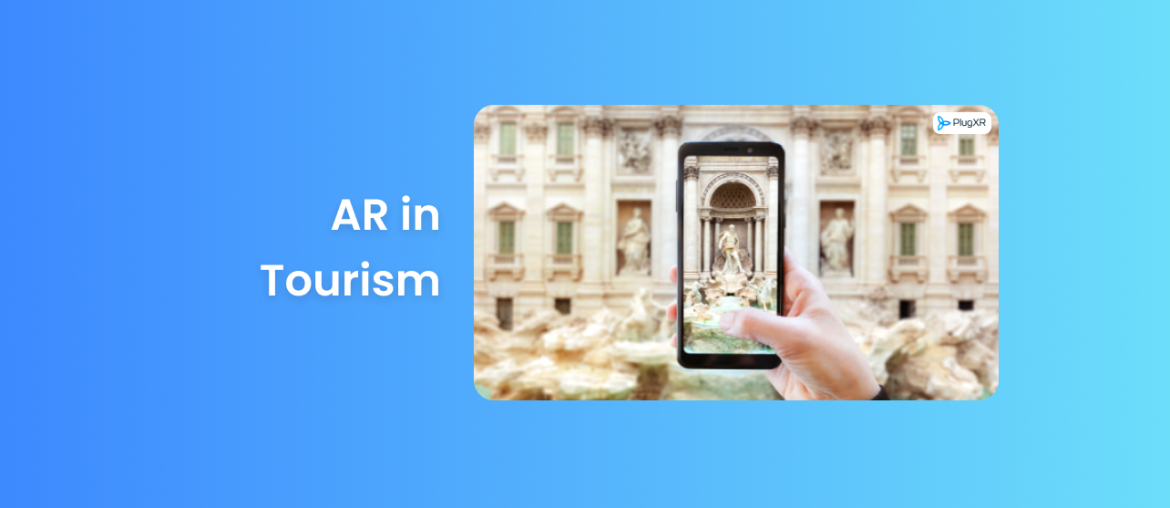
The travel and tourism industry has done fairly well with simulations – virtual reality, putting on expensive headsets, and whatnot. If you think this way, you are partially correct. It is one of the industries that has witnessed massive growth. Augmented Reality in tourism is one of those developments that has benefited tourism the most, growing from $15.52 billion worth of industry in 2023 to a projected $21.44 billion in 2024. It represents a compound annual growth rate (CAGR) of 38.1% between 2023-2024. It is not just growing in size, but it is also elevating how we travel to a certain extent in multiple ways.
Augmented Reality in Tourism – Top Use Cases
Today Augmented Reality is finding application in various ways, transforming how travelers experience destinations virtually. Here are the two main ways folks use AR to elevate people’s experience in traveling.
AR City Tour
Who doesn’t want to spend their days traveling to new cities and enjoying the varying cultures that sprout from there? Watching the Eiffel Tower in the morning and the Taj Mahal in the evening, doesn’t that sound like a dream for any traveler? With AR and its hyper-realistic augmentation, we are finally close to a world where it’s possible.
Many brands have already started to offer tours to particularly famous regions and cities. In the upcoming years, it will be perfected to a point where people can enjoy the ambiance of their dream city without worrying about travel expenses or work leave.
AR Museum Tour
Traditional museums are transforming. At least, many of them are on it -adding elements to the setup that excite modern-day travelers. Recently, many museums have started to provide AR tours, and visitors are embracing it. Imagine watching an ancient ship through 3D models or adorning armor worn by kings with AR museums. It is not just interesting but super cool now.
How is AR enhancing the tourism experience?
The most compelling ways AR is enhancing tourism are:
1. You can navigate unfamiliar places in AR for better awareness.
AR travel apps allow users to explore and preview unfamiliar destinations before visiting with the help of Interactive 3D maps that provide spatial awareness and logistics recreation, enabling its users to simulate walking through and practice navigating a new place, reducing uncertainties and giving them more confidence. It also lets visitors know what to expect and plan accordingly to avoid issues, navigate efficiently, and make the most of new destinations.
2. AR travel guides allow you to explore destinations from home.
It provides 3D renderings and interactive visuals of tourist destinations, allowing people to virtually explore them before visiting. You can know the ins and outs of the place you will visit beforehand and make decisions based on that.
3. AR tourism amplifies your recreation and entertainment needs.
AR technology allows immersive virtual tourism experiences, reducing costs and environmental impact. There are also Collaborative travel plans and gamified tours that add entertainment and make it more accessible and engaging.
How is the hospitality industry using AR?
Hospitality relies heavily on tourism, and it is also using AR for its growth. Here are the many ways they are using it:
1. Virtual room previews
Hotels use AR to let guests view and customize rooms before booking. It provides immersive experiences previewing accomodation and helps them explore the various options available during the visit. It also reduces the rate of cancellation for the hotels, thus reducing the losses.
2. Interactive guides
AR-based interactive guides give tourists self-guided tours of insights that feel surreal. For first-time visitors, it is a great utility when they can view and have a closer look at the intricacies of what they will likely get on their physical visit. It is a preview of the destination, its attraction attributes, and all other related information in an interactive and immersive manner, improving the overall experience.
3. Menu previews
Restaurants use AR so visitors can closely view food and beverage options digitally before ordering in their own space. Customers can see the ingredients and the finished dishes and interact with them uniquely.
4. Promotions and packages
Packaging is a great way to integrate AR and woo potential customers. Also, magazines, promotional collaterals, and brochures can attract tourists. And the hospitality industry is already pairing it with lucrative discounts to incentivize bookings.
5. Gaming and entertainment
Hotels embed AR games and visuals to make stays more engaging and personalized. These games and entertainment modules are related to local interactions, making it engaging for the visitors while they enjoy unparalleled experiences on their travels.
6. Operational efficiency
AR headsets assist staff with tasks like room servicing, maintenance checks, and locating items faster. Instead of visiting each room to perform the tasks, AR-based models can help them choose the rooms and places that need the most attention, increasing overall efficiency.
How is Augmented Reality in tourism benefiting the industry?
With AR in their various business applications, tourism elevates the tourists’ experience. The industry is going through a qualitative change and is abstracting many benefits:
Higher customer satisfaction
Reducing logistical uncertainties and stress for travelers is a big advantage. Previewing destinations and understanding navigation in advance make people feel more satisfied and in control during the real trip. It contributes to greater customer satisfaction.
Greater sales and conversion
AR and tourism apps encourage bookings by giving people an exciting preview of locations. The simulated previews enable customers to experience destinations first-hand from home. It builds confidence in the trip and increases conversion rates for related bookings like hotels, flights, and packages.
Improved collaboration
AR allows different tourism providers to collaborate and offer enhanced combined experiences. For example, a museum can partner with a local restaurant to provide an immersive exhibit tour and dining package. Alternatively, a hotel can collaborate with transit providers to offer AR previews of the city and how to navigate different sites.
What AR holds for tourism in the future?
Augmented Reality in the travel industry is forecast to grow steeply, reaching $78.14 billion by 2028. It reflects a 38.2% CAGR between 2024-2028. Many new variables will come into play to make this possible, like:
Multi-sensory experiences
Future Augmented Reality tourism may incorporate more senses beyond just visuals and audio. Tactile elements allow users to feel textures and environments. Smells could be simulated to make the experience more lifelike.
More convenient booking/planning
Augmented Reality apps may integrate firmly with travel booking platforms and providers. Users could book flights, hotels, and attractions directly within the AR experience for more seamless trip planning.
Expanded accessibility
AR holds the potential to make tourism more inclusive for those with disabilities or other limitations. People who cannot easily travel could still experience environments and cultures right from their homes.
Gamification
Gaming elements will increase engagement in tourism AR. Competitive scavenger hunts and other interactive adventures will be embedded in travel experiences.
Social connection
Augmented Reality in tourism will enable new ways to travel remotely with friends and family through shared virtual environments. The social connections of real trips can be replicated.
By elevating the experience for travelers and convenience for stakeholders, AR in tourism is a much-welcome change. If you are looking for a game-changing technology or want to level up the experience you provide your customers, consider PlugXR’s intuitive platform. Sign up or book a demo now to know more!
Write A Comment Cancel Reply
Save my name, email, and website in this browser for the next time I comment.

IMAGES
VIDEO
COMMENTS
The possibilities for augmented reality in the travel industry are vast. AR alters travelers’ perceptions of their physical surroundings and provides supplemental tourism experiences and...
Augmented reality (AR) is revolutionizing the way we travel and interact with the world. From interactive maps and personalised recommendations to remote assistants and translation apps, the potential for AR usage in tourism is boundless.
Explore the groundbreaking impact of Augmented Reality and Virtual Reality in travel. Discover how AR and VR are enhancing travel with interactive, immersive experiences. Dive into the latest trends and innovations shaping the future of travel with AR and VR technologies.
Augmented Reality (AR) and Virtual Reality (VR) are transforming many industries, including travel and tourism. Here we explore the different ways these technologies are used for things like ...
The metaverse is seen as the next evolution of the internet—a collective space where physical and digital worlds converge to deliver more immersive, interactive virtual- or augmented-reality (VR/AR) user experiences, often referred to together as extended reality (XR).
Augmented reality (AR) has benefited those operating in the travel industry, as they often sell experiences or physical environments.
Augmented Reality in tourism will enable new ways to travel remotely with friends and family through shared virtual environments. The social connections of real trips can be replicated. By elevating the experience for travelers and convenience for stakeholders, AR in tourism is a much-welcome change.
Augmented Reality is revolutionizing the way we experience and interact with the world, particularly in the realm of travel. From enhancing navigation and providing historical context to breaking down language barriers and offering personalized recommendations, AR is elevating the quality of travel experiences.
While virtual reality might be a virtual threat to the travel and tourism as being a potential substitute, augmented reality allows users to interact with the real environment that could potentially enhance visitors’ experience.
AR, VR and the metaverse will exponentially grow within our physical world, immersing travellers in a technology -driven trend that will continue far beyond 2023. VR helps travellers explore...